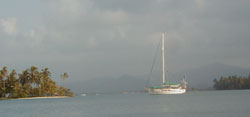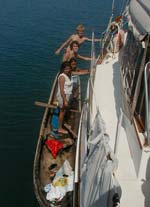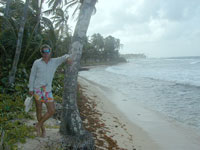|
November
25, 2000
Snug Harbor, between Apaitup & Kaymatar islands, San Blas
Latitude: 09-19.70N, Longitude: 078-15.10W
 We
have heard the San Blas Islands described as "the closest to
the South Pacific you can get without actuallygoingthrough the canal."
When we pulled into Snug Harbor, a group of four islands and two
islets two days beforeThanksgiving, we felt the saying fit. Instead
of a large humpy island like Piños, or crowded ones like
Usutupu or Achutpu, or mainland bays like Mono, we had pools of
deep blue water defined by shallow reefs glittering beneath the
surface and palm-lined islets with sandy beaches. It was a sunny
day with plenty of wind, (lets crank in those amps!), but the water
was flat and the boat sat steady. Perrrrrrfection! We
have heard the San Blas Islands described as "the closest to
the South Pacific you can get without actuallygoingthrough the canal."
When we pulled into Snug Harbor, a group of four islands and two
islets two days beforeThanksgiving, we felt the saying fit. Instead
of a large humpy island like Piños, or crowded ones like
Usutupu or Achutpu, or mainland bays like Mono, we had pools of
deep blue water defined by shallow reefs glittering beneath the
surface and palm-lined islets with sandy beaches. It was a sunny
day with plenty of wind, (lets crank in those amps!), but the water
was flat and the boat sat steady. Perrrrrrfection!
Snug Harbor
got its name from New England schooner-men that used to sail here
to trade for coconuts. To me this made a nice connection with the
upcoming Thanksgiving holiday, which it looked like we'd be celebrating
on our own as there wasn't another boat in sight. However, the next
day Cathy & Bob of the Tayana 37 Briana sailed in to make good
an earlier invitation to Thanksgiving dinner. We had, by the way,
a delightful T-day dinner with them featuring the sailor's favorite
micro-turkeys (Cornish hens!), stuffing, gravy, creamed onions,
mashed potatoes, peas, and cornmeal herb bread. No one's locker
gave forth either a can of cranberry sauce or of pumpkin for a pie,
so for dessert we made do with Bob's special chocolate mousse and
some champagne our friends on Sandi Lee had given me for my birthday.
The cruising life calls for all sorts of sacrifices!
Our fleeting
isolation has been whittled away day by day as more boats have found
their way here. Some of them are not even from our cruising group!
Imagine! Other boats! Of course, in the San Blas, no matter how
far you may think you are from a town, it is not so far that the
Kuna won't find you in their ulus (dugouts). Our first visitors
were fishermen who sold us some small lobsters and our first crab.
Then we were sold some coconuts. Then a mobile sahila came for our
fees. Then "Mr. Brown" who took our burnable trash. Etc.
Etc. Etc. Obviously it wasn't long before word got back to the town,
and there began a steady stream of mola salespeople, initially the
same fishermen and coconut tenders with their wives' offerings tucked
in a plastic bag in the back of their shorts, then eventually ladies
and kids.
 The
most unexpected mola salesmen we've had were Sean and Stu, two American
teenagers doing six months in Playon Chico via AFS student exchange.
They paddled out with their host "sisters", frankly admitted
to being "used" by their host mothers in hopes of their
English facilitating sales, and generally ate up a few hours of
English conversation between the three boats that were then anchored
here. Frankly, I suspect what they would really like to have eaten
up were a couple of greasy American cheeseburgers! We did buy two
molas, and we learned a lot from their "inside" perceptions. The
most unexpected mola salesmen we've had were Sean and Stu, two American
teenagers doing six months in Playon Chico via AFS student exchange.
They paddled out with their host "sisters", frankly admitted
to being "used" by their host mothers in hopes of their
English facilitating sales, and generally ate up a few hours of
English conversation between the three boats that were then anchored
here. Frankly, I suspect what they would really like to have eaten
up were a couple of greasy American cheeseburgers! We did buy two
molas, and we learned a lot from their "inside" perceptions.
One day we dinghied
to town, stopping on the way at Iskartupu, a tiny green jewel of
an island dedicated to a Kuna-run resort - "Sapibenega, The
Kuna Lodge". We'd noticed it as we sailed by when they saluted
us with a toot on a conch shell! A group had just left and they
had a few days before the next, a group from Spain, and although
things were definitely relaxed (the women in shorts and tank tops
instead of traditional dress (Aha! Caught 'em!), they received us
warmly and gave us a tour of the premises. We were quite impressed:
each room in the traditionally-built cane and thatch huts has real
beds as well as hammocks, modern bathroom facilities (including
eco-friendly composting toilets) and 12-volt lighting for around
$75 a night, all inclusive (except beer!) Activities include "presentations
of Kuna dances and other cultural manifestations (?)", fishing,
hiking into waterfalls, snorkeling at an offshore reef, and a chance
to paddle round and even sail in your own dugout canoe! The four
of us arranged to go back for dinner late that afternoon, and we
enjoyed a nicely presented meal of lobster, coconut rice and plantain
patties. Pepsi was included; beer was extra. It was not the $4 steal
that we had in Ustupu, and frankly it was almost exactly the meal
we'd cooked for ourselves the night before…but it is
always nice to be served! (Anybody who'd like information about
The Kuna Lodge can contact Paliwitur Sapibe, Sapibenega, The Kuna
Lodge, Playon Chico, Kuna Yala; Telephone 299 9116 in Panama!)
The town of
Playon Chico was a bit disappointing. We had no warm reception of
adults or children when we pulled up to the dock, perhaps because
we didn't arrive in the big boat but snuck in by dinghy. Nobody
guided us to a
sahila, but when Cathy expressed an interest in buying some "fruttab,"
a rather laconic teenager did end up taking us to a brand new cement
building that looked much like a jail to us, but turned out to be
a new "bank". The "bank's" three rooms were
currently piled high with coconuts in one room, plantains in another,
and green bananas in the third. The man in charge, a sahila-looking
gentleman, was the only welcoming soul we encountered. He bonded
right away with Don on the basis of two days in Indianapolis on
what sounded like quite the tour of the US some years ago. He was
happy to converse about his town, which is struggling between the
old ways and the new. Playon Chico has two schools, a technological
school and an agricultural school, but one negative aspect of this
is that Playon Chico has salaried people who can buy food while
others must get it the hard way. The hard way - subsistence agriculture
and fishing - suffers at this time of year when the seas are up.
This prevents the dugouts from fishing outside the barrier reefs.
On the other hand, we learned from our AFS students that a McDonalds
airplane flies into town twice a week to buy lobster for
McDonald's lobster rolls in Panama City! (Stu, the AFS student was
trying to work up his nerve to beg them to bring him some burgers!)
As we wandered our way back to the dock, we did find a pack of children
to dog our steps, but these kids seemed to lack the sparkle we'd
seen in Ustupu. However they have good memories, because they paddled
out to find their buddy "Don"several days later!
 Yesterday,
as the swell began to lay down a bit, we went exploring by dinghy
and snorkel hoping to find some reefs worthdiving. Outside were
some complex coral reefs, but viz was still low and fish non-existent,
so we left the scuba gearstowed! We did find a gorgeous lagoon behind
the fourth, hidden-from-view island of the cluster. The shallow
water coral there, filling up the space that would have made a gorgeous
anchorage, was healthy and beautiful, but still no fish. Yesterday,
as the swell began to lay down a bit, we went exploring by dinghy
and snorkel hoping to find some reefs worthdiving. Outside were
some complex coral reefs, but viz was still low and fish non-existent,
so we left the scuba gearstowed! We did find a gorgeous lagoon behind
the fourth, hidden-from-view island of the cluster. The shallow
water coral there, filling up the space that would have made a gorgeous
anchorage, was healthy and beautiful, but still no fish.
Speaking of food from the sea, we just bought three more crabs.
I can't end this update without a little account of cooking our
first crab. These are big guys, about 6-7" across the carapace,
with 1-2 wicked looking claws (depending on what fate has befallen
them). Our instructions told us to dismember them before cooking,
but didn't mention how to kill them. We
ended up steaming him whole and dismembering later. Problem is getting
him into the pot! Don dropped him into the steamer on his back,
shoving the bigclaw in under the lid. The other legs stuck out motivating
Don to reach for the camera. Before he could turn back, the protruding
legs started ejecting one by one, flying across the stove, down
in back, etc! Getting the meat out of the cooked body was his next
challenge. Instructions said "separate the top carapace from
the body", which didn't look likely to him, so, being a man,
he made a few exploratory bashes on the chest plate instead with
a tenderizing mallet, which got him nothing but a bunch of guts.
Imagine his astonishment when he went back to the original plan
and the carapace lifted right off! Lest anyone think I'm making
sexist cracks with my "man" comment, let just confess
right here and now that this girl was shirking all dismemberment
activities as much as possible!
We are, however,
making huge strides in our hunting and gathering. We have now moved
on to haggling over price, and getting three-fers, and, by God,
we'll dismember these guys first this time! On the other hand we
did purchase some embarrassingly tiny lobsters that yielded meat
about the size of a good-sized shrimp. We only hope we Mother Nature
has forgiven us since we released several of our purchases back
to the sea!
It will be hard
to leave Snug Harbor. It is a peaceful sort of place with fisherman
seining in the cool morning hours, blue herons cronking as they
fly over in pairs, and egrets wading the beaches. It is, however,
time to move on.
|